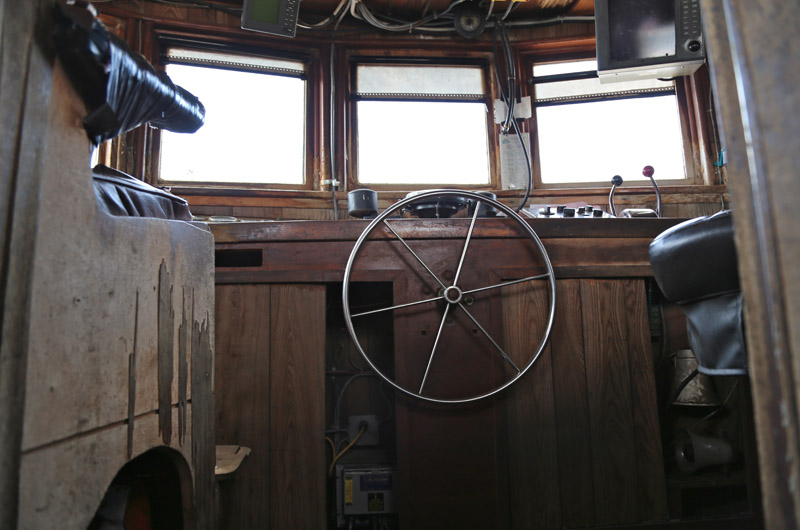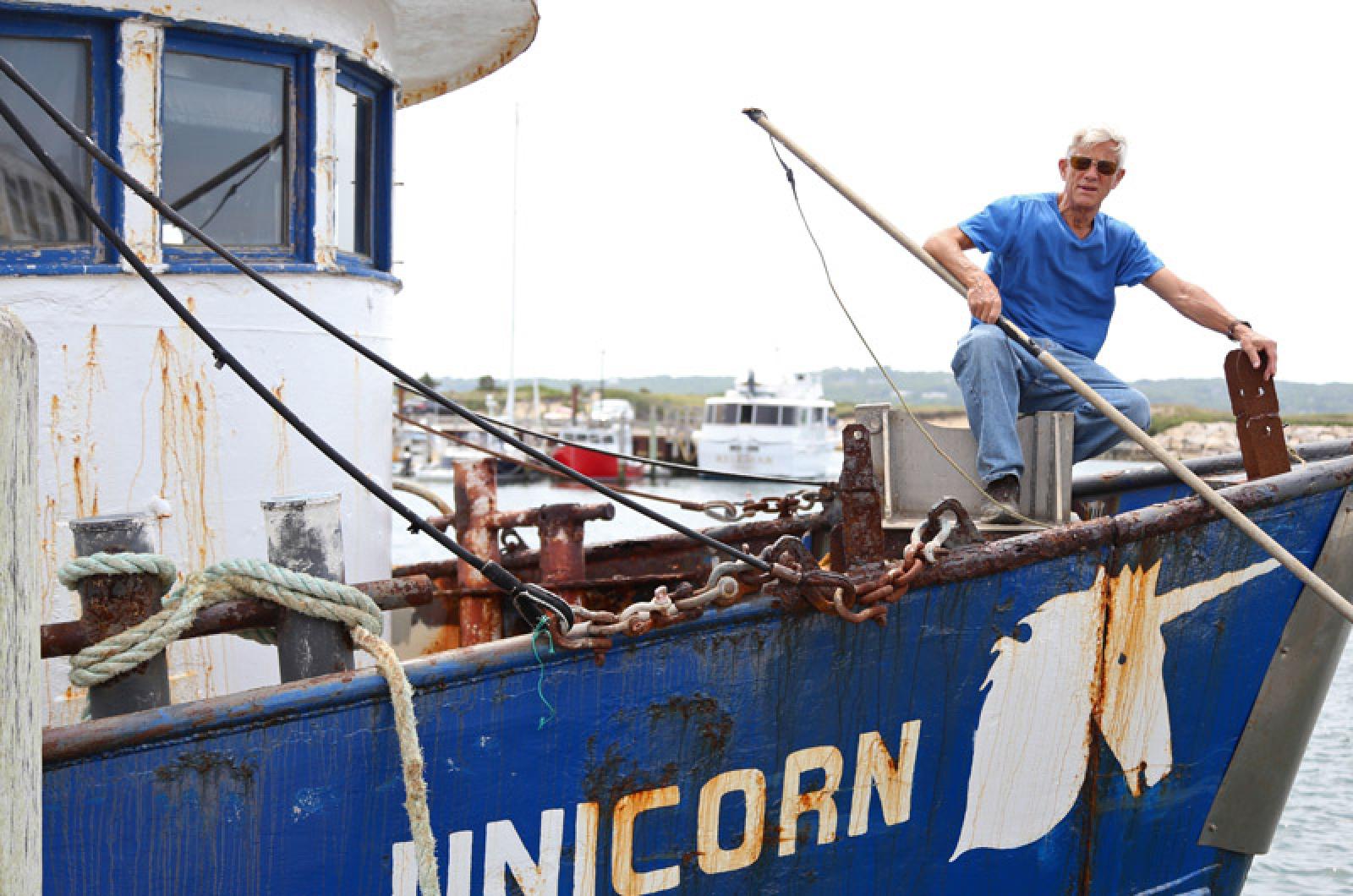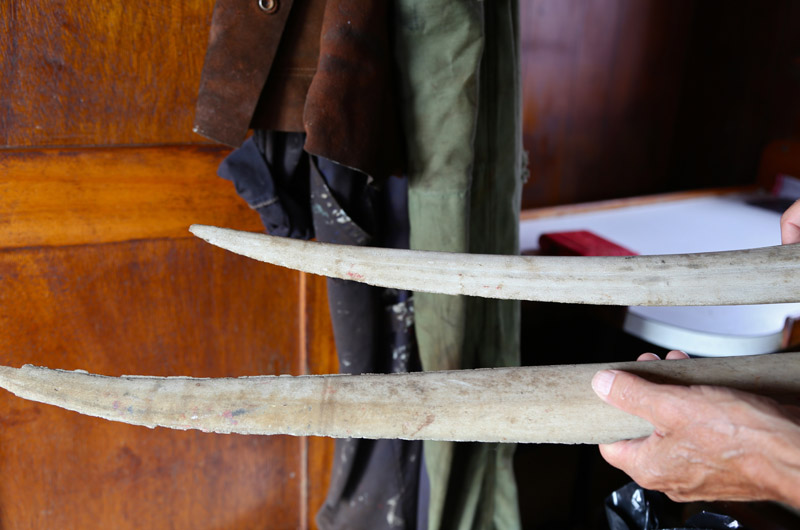On Wednesday afternoon, as young children peered into crab traps and people enjoyed lunch on the docks in Menemsha, the Unicorn dragger took up her usual spot near Larsen’s Fish Market. Her engine quietly rumbled, although no one was aboard. Strings of seaweed underneath her stern waved in the current.
Captain Greg Mayhew recently sold the ship’s groundfish permit — the last on the Vineyard — to The Nature Conservancy, which has partnered with the Martha’s Vineyard Fishermen’s Preservation Trust to help keep the groundfish quota in the community.
Without any federal or state permits, however, the old dragger is likely nearing the end of her long residency in the harbor.
Several generations of the Mayhew family have fished the waters around the Vineyard. Mr. Mayhew’s great-grandfather would sail out of Menemsha in a catboat to harpoon swordfish. Beginning in 1984, the Unicorn plied the waters between here and Georges Bank, harvesting groundfish, scallops and swordfish by the ton.
“I’ve probably harpooned more swordfish than anyone in North America,” Mr. Mayhew said. But beginning in the mid-1990s, regulations have greatly limited commercial fishing on the Island. The regulations have only increased, Mr. Mayhew said, leaving many small-scale fishermen unable to compete.
“I think an end of an era is coming,” said Chilmark harbor master Dennis Jason, who remembers when Menemsha was home to as many as 26 commercial draggers and 10 swordfishing boats. Only a handful of draggers now fish out of Menemsha in the summer, and of those, only the 89-year-old Little Lady hails from Chilmark. The Menemsha fleet lost two other commercial boats this year: the Robert C., which was accidentally rammed and sank off of Dogfish Bar, and the Lual, whose owner died suddenly of a heart attack. The Unicorn’s sister ship, Quitsa Strider II, was sold as scrap last year.

Mr. Mayhew paid more than $100,000 for the Unicorn in 1984 and invested another $300,000 over the years. But he said he would be lucky to recover even a tiny fraction of the cost. He mentioned one potential buyer in Point Judith, but 48 years is old for a steel dragger. “Some of the scrap guys aren’t even interested unless you’ve got equipment you can take off and sell,” he said.
Every two weeks or so, Mr. Mayhew will start up the engine and leave it running to charge the batteries. He took the boat fishing about 20 times last year, but she has not left the harbor since September.
The Unicorn was white when she first arrived in the harbor. Mr. Mayhew later painted her blue, with the name and a simple unicorn head stenciled on either side of the bow. The name itself draws from the Mayhew family seal, which includes the image of a unicorn, which Mr. Mayhew said reminded him of a swordfish.
For the Unicorn, the real turning point began in the 1990s, when the state applied a new size restriction on boats in response to concerns about overfishing in Nantucket Sound. The ship was three feet too long, so Mr. Mayhew was forced to shorten the bow. A new removable bow allowed him to continue fishing in state waters.
“It was a lot of fun fishing for swordfish, especially,” he said, looking back on the early days. Standing at the pulpit of the ship he would spear the swordfish with a 14-foot harpoon attached to a line and buoy. At the end of the day, he would retrieve the buoys.

“There were a couple times when I had 30 or 40 swordfish out,” he said, and the dying fish would attract sharks. “Sometimes it would take all night to try to find them.”
New regulations last year further reduced his allowable catch to just three swordfish per day, which he said made the $1,000 trip to Georges Bank even more unfeasible.
It was a similar story for groundfish, he said. Before the quota system, for example, he might have landed 25,000 pounds of yellowtail flounder in a single trip to Georges Bank. Following the change in 2011, he was allotted only 70,000 pounds per year. “[That] was pretty bad but we could sort of live with it, make a couple of trips,” he said.
The new quota system replaced a days-at-sea system that conservationists believed had contributed to the collapse of groundfish stocks. The quotas were administered based on landings from 1996 to 2006, a period when local fishermen had voluntarily shifted to more robust fisheries, Mr. Mayhew said. As a result, most of the quota went to factory ships that were more active during the allocation years.
“The ones that had the most to lose, they got the government regulators to pick certain years that a lot of the guys weren’t chasing either scallops or swordfish or other things,” he said.
At one time the Unicorn had a full-time scallop permit that might now be worth millions. But in the end Mr. Mayhew was allowed only 40 pounds of scallops per trip. Some scallopers lobbied for multi-ship ownership, he said, leading to large conglomerates where one person might hold 25 permits. “For the little guys,” he said, “it’s very difficult to wine and dine legislators.”
The Unicorn’s groundfish quota will now be available for Island fishermen to lease at an affordable rate. The Island fishermen’s preservation trust hopes to eventually own the permit and to buy others as well. It is also working to establish a revolving loan fund for Island fishermen.
Mr. Mayhew believes his groundfish permit might have gone for $150,000 to a private buyer. But given the challenges for small fishermen, he chose a different approach. “I was willing to take somewhat of a cut so they could keep it on the Island,” he said.









Comments (9)
Comments
Comment policy »